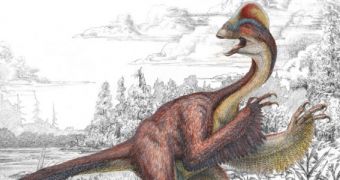A group of investigators in the United States, including scientists from the University of Utah, the Carnegie Museum of Natural History, and the National Museum of Natural History at the Smithsonian Institution announces the discovery of a new species of predatory dinosaur, which lived in the Dakotas alongside Tyrannosaurus Rex around 66 million years ago.
The newly-discovered species has been compared to a chicken from hell by investigators, who say that the animal weighed around 228 kilograms (500 pounds) and featured very long and sharp claws. The dinosaur was also very bird-like in appearance and most likely sported feathers over most of its body. Specimens discovered to date reveal the creature was around 3.5 meters (11.5 feet) long.
CMNH investigator Matt Lamanna, the lead author of the new study, says that the “chicken from hell” designation fits this predatory dinosaur like a glove. The new species is now called Anzu wyliei. The word anzu comes from an ancient Mesopotamian demon, which had the appearance of a bird. Wylie is the grandson of a CMNH trustee, who loves dinosaurs very much.
The new species is described in a paper entitled A New Large-Bodied Oviraptorosaurian Theropod Dinosaur from the Latest Cretaceous of Western North America, which appears in the March 19 online issue of the peer-reviewed, open-access scientific journal PLoS ONE. UU biology postdoctoral fellow Emma Schachner was one of the co-authors on the paper.
Anzu wylei was “a giant raptor, but with a chicken-like head and presumably feathers. The animal stood about 10 feet tall, so it would be scary as well as absurd to encounter,” she explains, adding that only three partial skeletons of this species were discovered to date. Between themselves, these remains are almost enough to assemble a full skeleton.
All bones were collected from a dig site in both North and South Dakota, more precisely from the uppermost levels of the Hell Creek rock formation. This feature is famous for the excellent T. Rex and Triceratops fossils it yields regularly. Anzu wylei is one of the few heavier dinosaurs to be discovered alongside these giants. Experts say the creature weighed 200 to 300 kilograms (440 to 660 pounds).
“I am really excited about this discovery because Anzu is the largest oviraptorosaur found in North America. Oviraptorosaurs are a group of dinosaurs that are closely related to birds and often have strange, cassowary-like crests on their heads.” Schachner adds.
The new species represents “one of the youngest oviraptorosaurs known, meaning it lived very close to the dinosaur extinction event,” she says. The dinosaurs are believed to have been killed off around 65.5 million years ago, when a massive asteroid impacted the ocean just off the Yucatan Peninsula, in Mexico. This is known as the Cretaceous-Paleogene (K-T) extinction event, or boundary.

 14 DAY TRIAL //
14 DAY TRIAL //